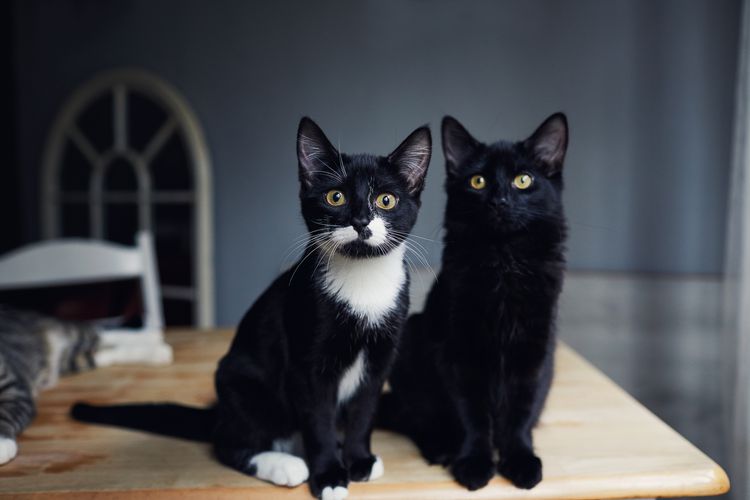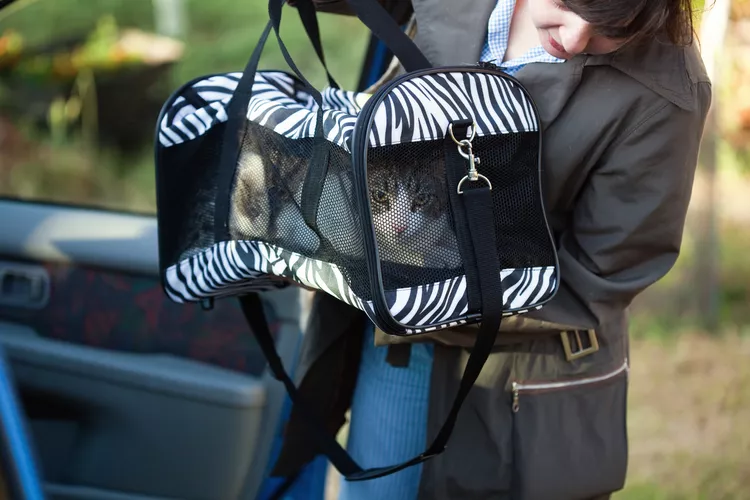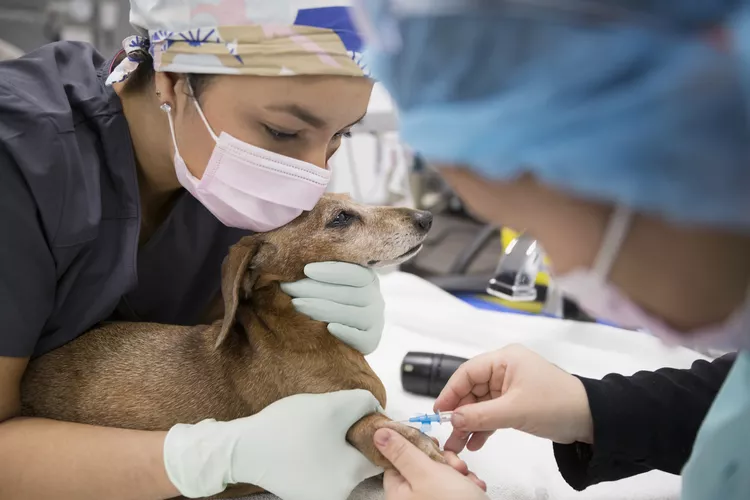
For a long time, cats have held a reputation for being solitary, and while they certainly aren't as social and gregarious as dogs are, cats can live in the same home and do well together. They can even become bonded to one another. One behavior you may see from time to time if you live in a multicat home is one cat slapping another cat. Why do cats do this? Are they fighting with one another? Or is something else going on?
A cat may slap another cat for a multitude of reasons. The trick to determining why your cats are slapping each other is to look at the rest of the body language and behavior of your cats. Cats slapping one another is a normal behavior for them, even if some of the reasons for it are less desirable.
Playful, energetic cats may slap each other as an invitation to play. Cats that are inviting play by slapping will have body language fitting a playful cat. Their whiskers will be forward and their attention given to the situation at hand. Their claws will be retracted for the slap so as not to hurt the other cat. There will be no yowling, screaming, or hissing from the cat that's doing the slapping. All of these nonverbal cues indicate to the other cat that the slapper wants to play.
Cats are obligate carnivores, meaning they require animal protein in their diet. This means they are also tiny little predators and, as such, they have a high prey drive. In fact, a lot of toys on the market actually tap into this. Feather wands, jingle balls, and laser pointers all exploit your cat's predatory instincts. Cats that don't have an appropriate outlet for these instincts may start to act out by pouncing on their housemates, or you. If your cat slaps another cat with all the hallmarks of playful body language but you feel they are still a little too exuberant about the slapping, they may be doing it because of a pent-up instinct to hunt.
If a cat isn't feeling well or if they are experiencing pain, they may slap other cats to get them to stay away. Cats suffering from chronic pain or chronic illness tend to be more guarded with other pets in the home.
They could be fearful of other pets accidentally hurting them. Cats don't necessarily show arthritic changes outwardly like dogs do. In fact, a study showed that 61% of cats over the age of 6 years had arthritic changes that could be seen in at least one joint on X-ray and 48% had changes in multiple joints.
It's important to note that the arthritis in these cats was diagnosed not by changes the owners had noted, but by X-rays. An older cat that has seemingly normal activity at home may be harboring arthritic pain. This could explain why a cat seems to get crankier with age; they could be in pain.
Again, it is possible for cats to live together with no issue, but that's not always the case. Sometimes cats don't get along with each other when they are living in close quarters. Cats that live together and fight are exhibiting something called inter-cat aggression, and that could be the reason they are slapping each other. The body language of cats slapping each other due to inter-cat aggression is dramatically different than cats slapping each other to instigate play. Cats that are acting out aggressively will appear tense. Their ears will be flat back against their heads and their faces will be tight, drawing their whiskers back against their faces. They will be vocalizing, making the proverbial angry cat sounds of growling, hissing, and screaming. Because every cat is an individual, inter-cat aggression can be a nuanced behavioral problem, but aggression can stem from a lack of resources in the home. Resources include things like litter boxes and water bowls, but they can also include toys, beds, and vertical spaces like cat trees and shelves.
Even though cats slapping one another is considered to be normal behavior, that doesn't mean your cats should be slapping each other. There are ways you can minimize the incidence of cats slapping one another.
If your cats are slapping each other because of play and instinct, instilling scheduled and structured play times can help. A cat that has the same scheduled 20 minutes every day to hunt and pounce on its favorite wand toy or chase the elusive red dot may be less likely to slap its housemates for play. It's important to remember that part of the fun of the hunt is catching the prey at the end. Laser pointers don't allow for this, so if your cat loves playing with them, end each play session by tossing them a kicker toy that they can jump on and bunny kick to "kill."
Keeping your cat up-to-date on its annual exams can help ensure there aren't any illnesses brewing that may be causing pain or discomfort. Cats tend to be nervous at the vet, and it can be difficult for your vet to accurately assess them to see if there are subtle signs of arthritis. Get a video on your phone of your cat walking around or jumping up on things; this can be a great help for your vet to determine if your cat has early arthritis. As your cat ages, consider starting them on a joint supplement. Your vet can recommend the best product for your cat.
Inter-cat aggression isn't always a quick-and-easy fix, but there are some things you can do to make home life less stressful for your cat. Ensuring there are an adequate number of litter boxes is a great start. Most behavior experts recommend the number of litter boxes in your home equals the number of cats you have, plus one. So, if you have two cats, you'd ideally have three litter boxes.
Experts also recommend that litter boxes be on every level of your home and not all clumped together on one floor or in one location.
You can also minimize inter-cat aggression by increasing the number of vertical spaces in your home. Cat shelves and cat trees, especially in high-traffic areas such as hallways, can relieve the stress of living in tight quarters while also giving cats a more appropriate outlet for their stress.
It's normal for cats to hit each other. That being said, it can mean a variety of things, and stopping it can require different strategies. If you have concerns about chronic pain in your cat or how to get your cats to get along better, speak to your veterinarian.

How to Take a Car Trip With Your Cat
Think you can't travel with your cat? Think again! Traveling with your cat just takes a little preparation and planning. Here's how.
How to Determine Your Cat's Age
Determining the age of an adopted cat is just guesswork, but a vet can look at teeth, sexual maturity, fur coat, and eyes to estimate.
Cat Food Ingredients to Avoid
When checking the nutrition content of cat food, look for ingredients that are not healthy or show it is of poor quality. Avoid these 3 ingredients.
What You Need to Know About Homemade Cat Food
If you want to cook for your cat, make sure to read about the risks associated with homemade diets for cats
Can Dogs Eat Raw Chicken Feet?
What are the potential health benefits of chicken feet for dogs? What are the risks?
Macadamia Nuts and other Nuts That Are Toxic to Dogs
Find out why macadamia and other nuts are poisonous to dogs, what signs to look for, and what is needed to treat the toxicity.
10 Tips for Taking Care of a Senior Dog
Is your dog a senior? Changes to their diet, exercise, and care are required. Here's how to make sure they're living their best and healthiest life.
Hookworms in Dogs
Hookworms can make a dog uncomfortable but may also lead to serious blood loss and anemia. Learn the causes, treatment, and prevention.
Is Swiffer WetJet Safe to Use Around My Pet?
ASPCA toxicologists deemed Swiffer WetJet to be safe for use around pets, but there are other all-natural floor cleaning options available.
Can Dogs Eat Bread?
Is bread a safe snack for you dog? Are there kinds of bread you should avoid? Learn more about whether it's okay to feed your dog bread.
14 Hypoallergenic Cat Breeds for People With Allergies
There are no true hypoallergenic cat breeds. But some, such as the Siamese and Siberian, might be less likely to cause allergies than others.
Burmilla: Cat Breed Profile, Characteristics & Care
The playful and social burmilla is one of the newest cat breeds to be officially recognized by the CFA. Learn about burmilla breed.
Nebelung: Cat Breed Profile, Characteristics & Care
The Nebelung is a rare breed of domestic cat that’s known for their long gray-blue fur and gorgeous green eyes. Learn about the Nebelung cat breed.
Cymric: Cat Breed Profile, Characteristics & Care
The Cymric, a long-haired Manx, is one of the world's oldest cat breeds. This tailless cat is friendly and playful. Learn about the Cymric breed.
Here's Why Cats Groom Themselves
Learn all about cats' grooming habits: how and why cats groom, including mutual grooming, over-grooming, and displacement grooming!
Pharaoh Hound: Dog Breed Characteristics & Care
Learn all about the Pharaoh hound, a sight hound dog breed known for their slim appearance and the ability to blush when excited.
How to Walk Your Dog
Dog walks should be fun for your dog while respecting your community. Learn why walking your dog is important and get essential safety and training tips.
How to Stop Your Dog From Whining
Whining is a natural way for your dog to communicate with you. Explore the reasons dogs whine and how to discourage your dog from whining too much.
How to Stop Your Dog From Barking Excessively
All dogs bark, but excessive barking is a behavior problem. Learn how to help stop excessive barking and prevent it from happening all the time.
How to Train Your Dog to Live With Another Dog
When you add a second dog to your household, it's natural that there will be an adjustment period. Learn how to get two dogs to become acquainted.